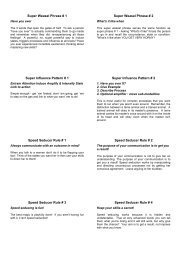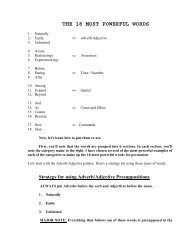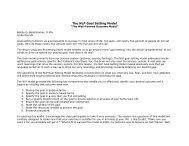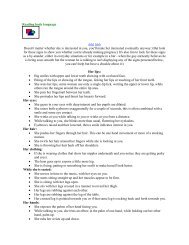A Pragmatic Guide To Communication & Change.pdf - NLP Info Centre
A Pragmatic Guide To Communication & Change.pdf - NLP Info Centre
A Pragmatic Guide To Communication & Change.pdf - NLP Info Centre
- No tags were found...
Create successful ePaper yourself
Turn your PDF publications into a flip-book with our unique Google optimized e-Paper software.
world of phenomena the relations that we have learned to observe among the parts<br />
of speech; we interpret what is happening in terms of the logic of cause-effect that<br />
is embedded in our grammar.<br />
Analog-Digital: The Computer Metaphor<br />
There are two kinds of computers in common usage today. A digital computer,<br />
like a ,alcnl.u<br />
6R<br />
66<br />
limits were built in to his model. With this information, you are not only able to pace his<br />
experience (gain/maintain rapport), you are also able to lead him in changing his<br />
perceptions and behaviors that are limiting and painful. This can be done verbally as well<br />
as nonverbally by utilizing all the analog systems of body posture, breathing, voice<br />
tonality, etc. The example which follows will demonstrate some of these techniques.<br />
A highly visual person has come in for an initial interview. You know this from a<br />
combination of body posturing, build, lip size, clothing, predicate usage and other cues.<br />
You already know that one of his rules for communicating is that it is necessary to look in<br />
order to understand what another person is saying. If you were to turn away or listen by<br />
diverting your head as many people do, he might accuse you of not paying attention. This<br />
poor pace could be compounded further if you placed yourself too close and "invaded his<br />
space." Remember that visually oriented people are generally more comfortable when<br />
they can see you from a distance in order to get "the whole perspective."<br />
By accepting this person's rules, by matching his predicates, in essence, by operating out<br />
of his model of the world, you begin to pave the road for a successful relationship. You<br />
can mirror various aspects of this person's communication category by matching your<br />
body posture, tonality, predicates, and by obeying the rules associated with that system.<br />
This will sometimes enable you to detect areas of pain and limits to this person's<br />
perception that would otherwise have remained hidden from you. At the same time you<br />
demon strate "acceptance" by mirroring, you provide the person with the opportunity to<br />
see, hear, and feel himself in ways which are usually outside of his conscious awareness.<br />
As long as the rapport is maintained, you can utilize this subtle form of feedback. For<br />
example, you can lead the person to a more comfortable or functional place by simply<br />
modeling those changes in yourself. By changing his "reflection" in this way, the person<br />
has the opportunity to actually experience new choices at a deep, unconscious level, to<br />
"try them on" so to speak. As long as you are open to subtly changes in the person you<br />
are working with, you can<br />
67<br />
immediately tell whether or not the changes are appropriate for him.<br />
These are just a few of the ways in which this information can be utilized. As you learn<br />
and experience the subtle patterns of communication covered in this book, you may find<br />
yourself generating more and more innovative applications in many different situations.<br />
A complete chart of all the behavioral characteristics associated with each of the<br />
communication categories is given in Appendix C.<br />
sa<br />
Where's the TV <strong>Guide</strong>?"<br />
Satir points out that there is often a difference between what the person's body appears
















